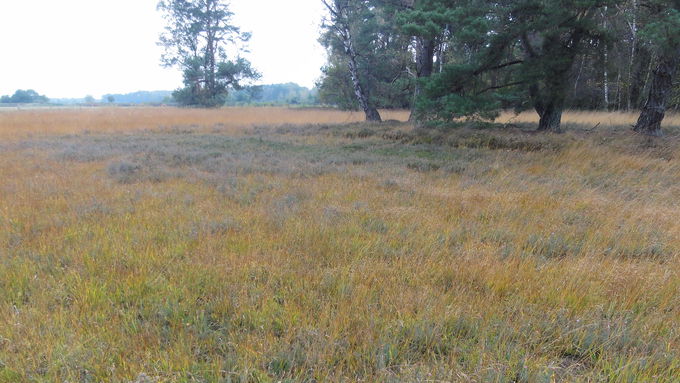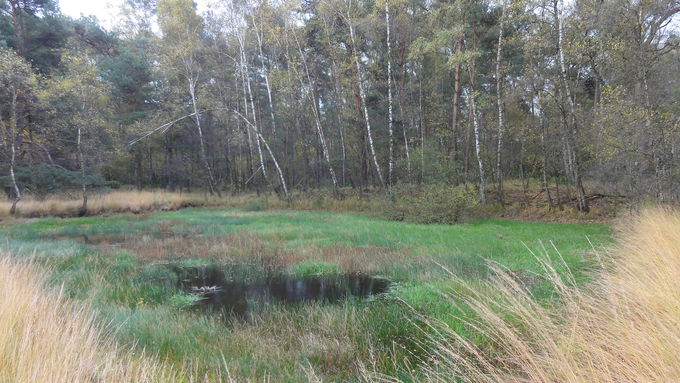A part of the wet heath before the start of the action in October 2017 © Corinna Kaiser, Bezirksregierung Münster
main content
Project of the month
#09/2020 OPTIMIZATION OF HEATH PONDS
Optimization and new creation of habitat type 3130 in the nature reserve ‘Heideweiher an der Flötte’
The nature reserve ‘Heideweiher an der Flötte’ in the district of Steinfurt covers an area of around 14 hectares and is located northeast of Saerbeck in a lowland area of groundwater-near sandy terraces which are locally muck. The area became nature reserve in 1984 and is part of a protected area system of several nutrient-poor wetland habitats in the district of Steinfurt. It is home to wet heath and two oligotrophic heath ponds with numerous endangered and threatened plant species, such as the oblong-leaved sundew (Drosera intermedia), marsh gentian (Gentiana pneumonanthe), marsh St. John's-wort (Hypericum elodes), marsh clubmoss (Lycopodiella inundata), bog-myrtle (Myrica gale), brown beak-sedge (Rhynchospora fusca) and marsh speedwell (Veronica scutellata).
More recently, however, the banks of the heath ponds have become increasingly overgrown and some areas of the wet heath have been heavily grassed with purple moor grass. As a result, for the particularly weak competitors and rare species of heath ponds there has been a lack of the required open ground areas.
In order to preserve the habitat type 3130 and to improve it as habitat for endangered animal and plant species, appropriate measures were therefore implemented in August 2018 in cooperation with the Biological Station of the district of Steinfurt and the Lower Nature Conservation Authority of the district of Steinfurt in the framework of the LIFE IP Atlantic Region DE.
In the area of the heath ponds which are located in wet heaths, emerging woody plants were cleared. Subsequently, the two heath ponds were desludged and the topsoil from parts of the wet heath was removed down to the sandy subsoil. Finally, an approximately 100-metre long fence on the west side of the area was renewed to protect it from the adjacent pasture.
The first positive developments already became apparent in early summer 2020: The measures implemented within the framework of the LIFE IP led to the resettlement of the white-flowered buttercup (Ranunculus ololeucos), a perennial aquatic plant that is threatened with extinction in North Rhine-Westphalia and very rare. Obviously, it had still been present in the sperm bank of the heathland pond and was able to germinate and blossom again due to the changed habitat conditions.
Related Topics
Further Links
- Nature reserve ‘Heideweiher an der Flötte’ – Landesamt für Natur und Umweltschutz (in German) (external link opens in a new window)
- Biological Station of the District of Steinfurt (in German) (external link opens in a new window)
- District of Steinfurt – Department for Nature and Landscape (in German) (external link opens in a new window)





